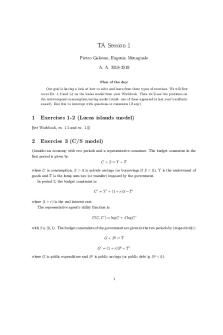TA 1 - ta1 PDF

| Title | TA 1 - ta1 |
|---|---|
| Course | Politica Economica |
| Institution | Università Commerciale Luigi Bocconi |
| Pages | 2 |
| File Size | 50.6 KB |
| File Type | |
| Total Downloads | 50 |
| Total Views | 153 |
Summary
ta1...
Description
TA Session 1 Pietro Galeone, Eugenia Menaguale A. A. 2018-2019
Plan of the day: Our goal is having a look at how to solve and learn from three types of exercises. We will first cover Ex. 1.2 and 1.3 on the Lucas model from your Workbook. Then we’ll see two problems on the intertemporal consumption/saving model (mind: one of these appeared in last year’s midterm exam!). Feel free to interrupt with questions or comments (if any).
1
Exercises 1-2 (Lucas islands model)
[See Workbook, ex. 1.2 and ex. 1.3]
2
Exercise 3 (C/S model)
Consider an economy with two periods and a representative consumer. The budget constraint in the first period is given by: C +S =Y −T where C is consumption, S > 0 is private savings (or borrowings if S < 0), Y is the endowment of goods and T is the lump sum tax (or transfer) imposed by the government. In period 2, the budget constraint is: C ′ = Y ′ + (1 + r)S − T ′ where (1 + r) is the real interest rate. The representative agent’s utility function is: U (C, C ′ ) = log C + β log C ′ with β ∈ (0, 1). The budget constraints of the government are given in the two periods by (respectively): G + Sg = T G′ = (1 + r)S g + T ′ where G is public expenditure and S g is public savings (or public debt ig S g < 0).
1
1. Derive the intertemporal budget constraint for the consumer and for the government; also derive the intertemporal consumption condition (i.e. the Euler equation). Do taxes influence the Euler condition? Explain. 2. Assume that the consumer internalizes (i.e. includes in her optimization) the government’s intertemporal budget constraint. Derive a single intertemporal budget constraint, and combine it with the Euler condition to derive the expression for the optimal period-one consumption C ∗ for a given real interest rate r. What is the effect of a tax increase on current consumption (holding G and G′ constant)? Explain. 3. Using the optimal consumption function you just obtained, and assuming that the interest rate r is fixed (i.e. partial equilibrium), derive the value of the government expenditure multiplier on consumption. In other words, what is the value of the effect ∂C ∗ /∂G? 4. Now let’s move from the partial to the general equilibrium. In other words, let’s consider r to be endogenous (consider credit market equilibrium). First, equilibrium in the goods market requires: Y =C +G Show how you can obtain this condition starting from the credit (= savings) market equilibrium. 5. Second, we can derive the general-equilibrium multiplier by combining the Euler condition with the market equilibrum condition just derived, thus endogenizing r. With the resulting expression for consumption (call it C ∗∗ ), calculate the multiplier ∂C ∗∗ /∂G. 6. Compare this value for the multiplier just obtained with the one calculated in point 3. What are the differences? How can you make sense of them?
3
Exercise 4 (C/S model)
Consider a two-period model, with real interest rate r > 0. The representative consumer has the following utility function: U = log C + β log C ′ . Write and solve the problem of the agent. Then, analyze the following scenarios: 1. a fall in r (i.e. expansionary monetary policy), in absence of a government; 2. a fall in T (i.e. expansioanry fiscal policy), keeping public expenditure G and G′ constant.
2...
Similar Free PDFs

TA 1 - ta1
- 2 Pages

TA1 - Microeconomía - TA 1
- 11 Pages

TA1- Precios - ta 1
- 19 Pages

Precios TA1 - INDICACIONES DE LA TA
- 23 Pages

TA1 Entrega - ESTRUCTURA 1
- 3 Pages

TA1 Grupo 5 - TA1
- 2 Pages

TA1 Plan comercial 1
- 15 Pages

Tarea Académica 1 - TA1
- 16 Pages

TA 2 - TA 2
- 2 Pages

TA1 Digital - TA1 mkt dig
- 17 Pages

TA-1 Micro 2020-1
- 3 Pages

TA1 - Precios
- 22 Pages

TA 0521 1+Simplificada+(V9)
- 3 Pages

TA JCEE
- 3 Pages
Popular Institutions
- Tinajero National High School - Annex
- Politeknik Caltex Riau
- Yokohama City University
- SGT University
- University of Al-Qadisiyah
- Divine Word College of Vigan
- Techniek College Rotterdam
- Universidade de Santiago
- Universiti Teknologi MARA Cawangan Johor Kampus Pasir Gudang
- Poltekkes Kemenkes Yogyakarta
- Baguio City National High School
- Colegio san marcos
- preparatoria uno
- Centro de Bachillerato Tecnológico Industrial y de Servicios No. 107
- Dalian Maritime University
- Quang Trung Secondary School
- Colegio Tecnológico en Informática
- Corporación Regional de Educación Superior
- Grupo CEDVA
- Dar Al Uloom University
- Centro de Estudios Preuniversitarios de la Universidad Nacional de Ingeniería
- 上智大学
- Aakash International School, Nuna Majara
- San Felipe Neri Catholic School
- Kang Chiao International School - New Taipei City
- Misamis Occidental National High School
- Institución Educativa Escuela Normal Juan Ladrilleros
- Kolehiyo ng Pantukan
- Batanes State College
- Instituto Continental
- Sekolah Menengah Kejuruan Kesehatan Kaltara (Tarakan)
- Colegio de La Inmaculada Concepcion - Cebu

